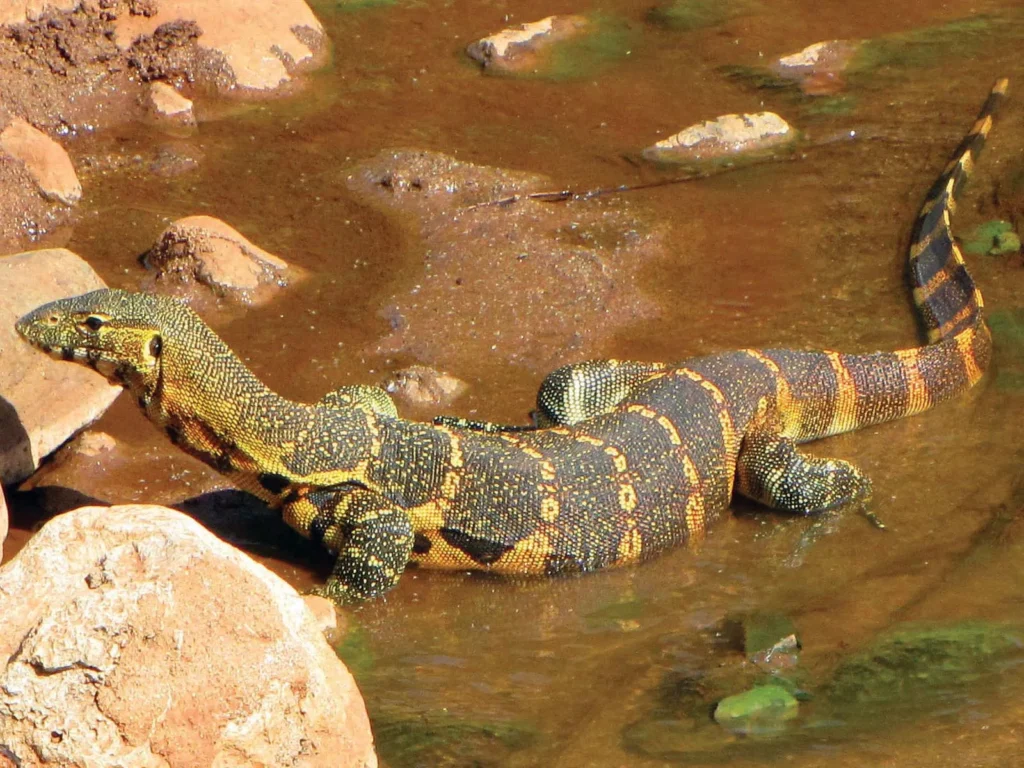Monitor lizards are often portrayed in popular media as dangerous, aggressive creatures that can pose serious threats to humans. From movies and TV shows to sensationalized news stories, it’s easy to see why many people might be fearful of these reptiles. However, the reality of monitor lizards is far more nuanced. While some species of monitor lizards can be potentially dangerous, the truth about their behavior, temperament, and interactions with humans might surprise you. In this blog post, we’ll delve into the facts and myths surrounding monitor lizards and explore whether or not they truly deserve their menacing reputation.
What Are Monitor Lizards?
Monitor lizards belong to the genus Varanus, which includes around 80 different species of reptiles. These lizards are native to Africa, Asia, and Australia and are known for their long, muscular bodies, sharp claws, and powerful jaws. They range in size from the small, relatively harmless Varanus brevicauda to the giant Komodo dragon (Varanus komodoensis), which can grow up to 10 feet long and is the largest living lizard species on Earth.
These reptiles are skilled hunters and are often carnivorous, preying on smaller animals, eggs, insects, and even fish. Their sharp claws and long tails help them navigate through their environments, climb trees, and capture prey. Monitor lizards are also known for their intelligence, social behaviors, and in some species, even the ability to use tools, making them stand out in the reptile world.
The Myth: Monitor Lizards Are Aggressive and Deadly
One of the most common misconceptions about monitor lizards is that they are inherently aggressive and dangerous to humans. This myth likely stems from the Komodo dragon, which has been known to attack and even kill humans in rare instances. Due to its size and powerful bite, the Komodo dragon has earned its place in the media as a fearsome predator.
However, the vast majority of monitor lizard species are not nearly as aggressive as people assume. While some species can display territorial behaviors or may become defensive if they feel threatened, most monitor lizards are not actively seeking out confrontation with humans. In fact, many species are shy and will avoid human contact if given the opportunity. Aggression is typically seen in monitor lizards only when they feel cornered or provoked, which is a natural survival instinct for many animals.
The Facts: Understanding Monitor Lizard Behavior
To better understand whether monitor lizards are dangerous, we need to take a closer look at their natural behavior and interactions with humans. While some species of monitor lizard can pose risks, particularly if they are threatened or feel unsafe, the actual danger they present is often exaggerated.
- Size Matters: Larger monitor lizards, such as the Komodo dragon, are capable of delivering powerful bites, but even these species are more likely to avoid humans unless they feel provoked. Smaller species, such as the Bengal monitor (Varanus bengalensis) or the savannah monitor (Varanus exanthematicus), are less likely to be dangerous to humans, as they are not large enough to inflict significant harm. Most monitor lizards are not inclined to attack unless they feel that their safety is at risk.
- Defensive Behavior: Monitor lizards are more likely to display defensive behaviors rather than offensive aggression. When threatened, many monitor species will hiss, display their sharp claws, and puff up to make themselves appear larger. These warning signs are meant to intimidate potential threats and avoid direct confrontation. In most cases, if left undisturbed, the lizard will simply retreat to a safer area.
- Intelligence and Curiosity: Monitor lizards are known for their intelligence, which is much more developed than that of many other reptiles. They are curious creatures and will often approach humans out of interest rather than hostility. For example, monitor lizards in the wild or in captivity may observe their environment and interact with humans without displaying any signs of aggression. This curiosity should be respected, but it does not inherently mean the lizard is dangerous.
- Venom and Infection Risk: One of the reasons the Komodo dragon is considered dangerous is its venomous bite. While the venom of the Komodo dragon can cause significant damage and lead to infection, not all monitor lizards have venom. The Komodo dragon’s venom works by causing rapid blood loss, paralysis, and shock, making it a deadly predator. However, other species of monitor lizards, such as the common monitor (Varanus salvator) or the water monitor (Varanus salvator), do not possess venom and are unlikely to pose such a significant threat to humans. Even so, any bite from a monitor lizard can still lead to an infection, so it is important to treat bites with proper care.
- Monitor Lizards as Pets: For many reptile enthusiasts, monitor lizards are kept as pets. While larger species like the Komodo dragon are not suitable for captivity due to their size and specific habitat needs, smaller species, such as the Savannah monitor, can be kept as pets with the right care. When raised in a controlled environment and treated with respect, monitor lizards are generally not dangerous. However, they do require proper handling and care to avoid stress and potential defensive reactions.
The Reality: Monitor Lizards Are Not Out to Harm Humans
In reality, monitor lizards are not naturally inclined to attack humans. Like many other animals, they prefer to avoid confrontation and will only act aggressively if they feel threatened or provoked. While their size, claws, and sharp teeth can be intimidating, the majority of monitor lizard species are not a danger to humans unless they are cornered, mistreated, or feel endangered.
In most cases, monitor lizards are solitary creatures that will focus on finding food and maintaining their territory rather than seeking out human interaction. If you encounter a monitor lizard in the wild, it is important to respect its space and avoid sudden movements. By giving the lizard plenty of room to move and retreat, you can ensure a safe interaction for both yourself and the animal.
Frequently Asked Questions (FAQs) About Monitor Lizards
1. Are all monitor lizards dangerous to humans?
Not all monitor lizards are dangerous to humans. While some species, such as the Komodo dragon, can pose a threat due to their size and venomous bite, the majority of monitor lizards are not inherently aggressive. Most species are shy and will avoid human interaction unless they feel threatened or cornered. Smaller monitor species, such as the savannah monitor, are often kept as pets and are generally not dangerous to humans when handled properly.
2. Can a monitor lizard kill a human?
While it is extremely rare, a monitor lizard can potentially kill a human, especially in the case of large species like the Komodo dragon. The Komodo dragon’s venomous bite can lead to rapid blood loss and infection, making it a dangerous predator. However, the vast majority of monitor lizards are not a danger to humans and would rather avoid confrontation.
3. How can you tell if a monitor lizard is aggressive?
Monitor lizards typically display aggressive or defensive behaviors when they feel threatened. These behaviors may include hissing, puffing up their body to appear larger, and showing their sharp claws or teeth. If a monitor lizard feels cornered, it may attempt to defend itself by biting. If you see these signs, it’s important to give the lizard plenty of space and avoid provoking it.
4. Are monitor lizards venomous?
Not all monitor lizards are venomous. The Komodo dragon is the most well-known venomous monitor lizard, but most species, including the common monitor and water monitor, do not possess venom. Even without venom, however, a bite from a monitor lizard can still lead to infection, so it’s important to handle them carefully and avoid getting bitten.
5. Can a monitor lizard be kept as a pet?
Yes, many smaller species of monitor lizards, such as the savannah monitor and the Ackie monitor, can be kept as pets. They are relatively docile when raised in captivity and can form strong bonds with their owners. However, they require a specialized environment, including the proper temperature, humidity, and diet. It’s important to research the specific needs of the species you plan to keep and ensure you can provide a suitable habitat.
6. What do monitor lizards eat?
Monitor lizards are typically carnivorous and eat a variety of prey, including small mammals, birds, insects, eggs, and reptiles. Some species, such as the water monitor, may also consume fish. In captivity, pet monitor lizards are usually fed a diet of insects, rodents, and occasionally small fish or eggs, depending on the species.
7. How do monitor lizards hunt?
Monitor lizards are skilled hunters and often rely on their sharp claws, keen sense of smell, and intelligence to track down and capture prey. They may use their strong limbs to climb trees or dig for burrowing animals. Larger species, like the Komodo dragon, may use ambush tactics, while smaller species often chase down their prey. Monitor lizards are also known to scavenge and may feed on carrion if the opportunity arises.
8. Are monitor lizards good swimmers?
Yes, many species of monitor lizards are excellent swimmers. The water monitor (Varanus salvator), for example, is highly adapted to aquatic environments and spends a significant amount of time in or near water. Monitor lizards use their powerful tails to propel themselves through the water and can dive to chase prey or escape predators.
9. How long do monitor lizards live?
The lifespan of a monitor lizard can vary depending on the species. Smaller species typically live around 10 to 15 years in captivity, while larger species, like the Komodo dragon, can live up to 30 years or more. Proper care, diet, and habitat are essential to ensuring a monitor lizard lives a long and healthy life in captivity.
10. What should I do if I encounter a monitor lizard in the wild?
If you encounter a monitor lizard in the wild, the best course of action is to remain calm and keep your distance. Monitor lizards are generally not aggressive unless they feel threatened. Avoid sudden movements or attempts to approach the lizard, as this may cause it to feel cornered. If you’re in a region where monitor lizards are common, observe from a safe distance and respect the animal’s space.
Conclusion
Monitor lizards are often misunderstood, and many of the myths surrounding them exaggerate their danger to humans. While certain species, like the Komodo dragon, can indeed pose a threat, the vast majority of monitor lizards are not aggressive by nature and will only become defensive if provoked. By understanding their behaviors and respecting their space, we can safely coexist with these fascinating reptiles and appreciate the important role they play in their ecosystems.
As with any wild animal, monitor lizards should be treated with caution and respect, but it’s important to remember that they are not inherently dangerous. With the right knowledge and precautions, humans and monitor lizards can peacefully share the planet without fear.


